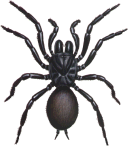|
Funnel-Web
Spiders...deadly and aggressive
|

|
|
|
FEMALE
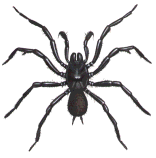 MALE
MALE |
|
Venom
toxicity - the Sydney Funnel-Web Spider is one of the world's
most deadly spiders. Both the male and female carry atraxotoxin,
one of the world's most dangerous toxins. The Blue Mountains
Funnel-Web and Northern Tree Funnel-Web Spiders are also highly
venomous.
Danger time - the mature male funnel-web
spider will wander around during hot humid nights, looking for
a
mate, and is known to enter homes, footwear, clothing, washing
and swimming pools where they can survive several days under
water.
It is highly aggressive when disturbed or cornered and is able
to inflict multiple bites, with its "flick-knife" hardened fangs. People
also find funnel-web spiders wandering around the garden or in the
home after heavy rain or nearby earthworks. An anti-venom is available
in most major hospitals and ambulance vehicles in "funnel-web country".
First aid and medical attention (ambulance) should be sought
as
soon as possible, if bitten.
Spider Identification
- an adult male 25 mm - female 30 mm in body length - shiny black
in colour with a dark purplish brown abdomen- reddish hairs. Unique
attributes include it's long spinnerets, that is , the 2 appendages
on the end of the abdomen and the male has a spur on 2 of it's legs
- refer to illustration on left.
Area of distribution - the Sydney Funnel-Web
Spider is a ground dweller in moist soil areas along much of the
eastern coastal area of New South Wales and Victoria.
The Blue Mountains Funnel-Web Spider is found mainly in the Blue
Mountains area, as far west as the Bathurst - Orange region and
occasionally in the Sydney basin.
The Northern Tree Funnel-Web Spider is found in south-eastern Queensland
and northern New South Wales as far south as the Hunter Valley region.
CLICK HERE for
more info on Funnel-Web Spiders
CLICK HERE
- FIRST AID - Funnel-Web Spider Bite
|
|
Red-Back
Spiders...highly venomous
- can be deadly
|

|
|
|
Venom toxicity - the Red-Back Spider
can inflict a painful bite which can be fatal, especially to the
young and elderly. An effective anti-venom was developed in 1956.
About 250 people receive the anti-venom each year. Only a small
amount of venom can cause serious illness, as the poison attacks
the nervous system. Systemic envenomisation usually results in headache,
nausea, vomiting, abdominal pain, pyrexia, hypertension and in severe
cases, paralysis. The pain around the bite area can be excruciating.
First aid and medical attention (ambulance) should be sought as
soon as possible, if bitten.
Area of distribution - Australia-wide.
Spider Identification - size varies
greatly - the male can be tiny, with the abdomen of the female growing
to the size of a large pea. Red-Back Spiders do NOT always have
a "red" marking.
Habitat - prefers dry habitats - often
found in out-houses, letter boxes, undersides of seats, in rubbish,
such as empty cans, in the sub floor and other dark areas. Electric
lights attract their prey - moths, flies, mosquitoes and other insects.
CLICK HERE for
more info on Red-Back Spiders
CLICK
HERE - FIRST AID - Red-Back Spider
Bite
|
|
White-tailed
Spiders: venomous - dangerous?
|

|
|
|
Venom toxicity - the bite of a white-tail spider may cause
nausea and burning pain followed by swelling and itchiness around
the site of the bite. In some rare but dramatic cases, a severe allergic
reaction, blistering or ulceration of the skin, similar to gangrene,
has been reported in the media and linked to the bite of a white-tail
spider. However, this cause/effect relationship has not been proven
conclusively to the satisfaction of some scientific researchers. Bacterial
infection of the wound caused by Mycobacterium ulcerans carried
on the fangs of the white-tail spider, may be a contributory factor.
In any case, first aid and medical attention should be sought, if
bitten, as and when any adverse health effects are observed.
Area of distribution - Australia-wide.
Spider Identification - adult size
varies 12 to 20 mm in body length - grey to black in colour with a
white section on the end of it's tail - as illustrated.
Habitat - prefers cool moist location
- commonly found in garden mulch areas. In summer, it often wanders
into buildings, particularly bathrooms, to escape the heat.
CLICK HERE for
more info on White-Tail Spiders
CLICK HERE
- FIRST AID - White Tail Spider Bite
|
|
Mouse Spiders...venomous
- painful bite
|

|
|
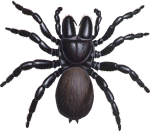 FEMALE
FEMALE
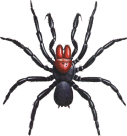 MALE
MALE
|
|
Venom toxicity - known to cause severe
illness, especially to young children - similar to Red-Back Spider.
Although normally not aggressive, the male mouse spider will bite
if provoked, and should be considered dangerous to humans. It has
large hard fangs which can cause a deep painful bite. First aid and
medical attention (ambulance) should be sought as soon as possible.
Area of distribution - Australia-wide.
Spider Identification - a medium
to large spider of up to 35 mm in body length. The male Mouse Spider
often has a bright red head and elongated fangs.
The Mouse Spider is often mistaken for the Funnel-Web Spider. The
main differences being the Funnel-Web has much longer spinnerets (the
2 appendages on the end of the abdomen) and the male funnel-web has
a spur on it's second leg - as illustrated above.
Habitat - Mouse spiders are ground
dwellers with burrows of more than 1 metre deep. The male often wanders
about during the day on open ground, especially after rain, in search
of females.
CLICK HERE for more
info on Mouse Spiders
CLICK HERE
- FIRST AID - Mouse Spider Bite
|
|
Black House
Spiders...venomous - nausea
|

|
|
|
Venom toxicity - the bite of the Black
House Spider is poisonous but not lethal. Certain people bitten experience
severe pain around the bite site, heavy sweating, muscular pains,
vomiting, headaches and giddiness. First aid and medical attention
(ambulance) should be sought as soon as possible.
Area of distribution - Australia-wide.
Spider Identification - adults are
about 15 mm in body length and of a dark brown to black velvet textured
appearance.
Habitat - this spider spins a lacy, messy
web and is prefers dry habitats in secluded locations. It is commonly
found in window framing, under eaves, gutters, in brickwork, sheds,
toilets and among rocks and bark. Electric lights attract their prey
- moths, flies, mosquitoes and other insects.
CLICK HERE for
more info on Black House Spiders
CLICK HERE
- FIRST AID - Black House Spider Bite
|
|
Wolf Spiders...venomous
- non-aggressive
|

|
|
Venom toxicity - the bite of the Wolf
Spider is poisonous but not lethal. Although non-aggressive, they
bite freely if provoked and should be considered dangerous to humans.
The bite may be very painful. First aid and medical attention should
be sought as soon as possible, particularly as to children or the
elderly.
Area of distribution - Australia-wide.
Spider Identification - an adult
is 15 mm to 30 mm in body length - mottled grey to brown in colour,
with a distinct Union Jack impression on it's back. The female carries
it's young on it's back.
Habitat - this spider is a ground dweller,
with a burrow retreat. It has a roving nocturnal lifestyle to hunt
their prey and can move very rapidly when disturbed. Commonly found
around the home, in garden areas with a silk lined burrow, sometimes
with a lid or covered by leaf litter or grass woven with silk as a
little fence around the rim of the burrow.
CLICK HERE for more info
on Wolf Spiders
CLICK HERE
- FIRST AID - Wolf Spider Bite
|
|
Trap-Door
Spiders...low risk - non-aggressive
|

|
|
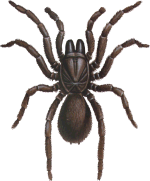 FEMALE
FEMALE
|
|
Venom toxicity - the bite of the Trap-Door
Spider is of low risk (non toxic) to humans. It is a non-aggressive
spider - usually timid but may stand up and present it's fangs if
harassed. Rarely bites - but if so it can be painful.
Area of distribution - Australia-wide.
Spider Identification - an adult
is about 35 mm in body length - brown to dark brown in colour - heavily
covered with fine hairs. The male has distinct boxing glove-shaped
palps, that is, the two "sensory feelers" at front of it's head.
Habitat - this spider is a ground dweller,
with a burrow retreat lined with silk of up to 250 mm in depth and
around 25 mm in width - prefers nesting in drier exposed locations
- often has a wafer-like lid on the burrow entrance. Trap-Door Spiders
are commonly found in the drier open ground areas around the home.
CLICK HERE for more
info on Trap Door Spiders
CLICK HERE
- FIRST AID - Trap Door Spider Bite
|
|
Orb-Weaving
Spiders...low risk - non-aggressive
|

|
|
|
Venom toxicity - the bite of Orb-Weaving
Spiders is of low risk (not toxic) to humans. They are a non-aggressive
group of spiders. Seldom bite. Be careful not to walk into their webs
at night - the fright of this spider crawling over one's face can
be terrifying and may cause a heart attack, particularly to the susceptible
over 40 year olds.
Area of distribution - Australia-wide,
particularly common in bushland along the eastern coastal areas.
Spider Identification - an adult
is about 20 mm to 30 mm in body length - has a bulbous abdomen - often
colorful - dark to light brown pattern. The common Golden Orb-Weaver
Spider has a purplish bulbous abdomen with fine hairs.
Habitat - often found in summer in garden
areas around the home - they spin a large circular web of 2 metres
or more, often between buildings and shrubs, to snare flying insects,
such as, flies and mosquitoes.
CLICK HERE
for more info on Orb-Weaving Spiders
CLICK HERE
- FIRST AID - Orb-Weaving Spider Bite
|
|
St Andrews
Cross Spiders...low risk
- non-aggressive
|

|
|
Venom toxicity - the bite of the St Andrews
Cross is of low risk (non-toxic) to humans. They are a non-aggressive
group of spiders.
Area of distribution - Australia-wide.
Spider Identification - adult 5
to 15 mm in body length - abdomen striped yellow and brown - as illustrated.
The St Andrews Cross Spider usually sits, upside down, in the middle
of it's web forming a cross - as illustrated.
Habitat - this spider is a web-weaver
usually found in summer in garden areas around the home. It is considered
beneficial as it spins a large web to snare flying insects, such as
flies and mosquitoes.
CLICK
HERE for more info on St Andrews Cross Spiders
CLICK HERE
- FIRST AID - St Andrews Cross Spider
Bite
|
|
Huntsman Spiders...low
risk - non-aggressive
|

|
|
|
Venom toxicity - the bite of Huntsman
Spiders is of low risk (non toxic) to humans. They are a non-aggressive
group of spiders. However, a large individual can give a painful bite.
Beware in summer when the female Huntsman Spider is guarding her egg
sacs or young.
Area of distribution - Australia-wide.
Spider Identification - an adult
varies greatly around 15 mm in body length - has long legs - the diameter
of an adult including legs may reach 45 mm - the first 2 pairs of
legs are longer than rear two - it is hairy - buff to beige brown
in colour, with dark patches on the body.
Habitat - a hunter that prefers to live
under the flaking bark of trees, under flat rocks and under eaves
or within roof spaces of buildings. The Huntsman Spider often wanders
into homes and is found perched on a wall. It is a shy, timid spider
that can move sideways at lighting-fast speed when disturbed.
CLICK HERE for more
info on Huntsman Spiders
CLICK HERE
- FIRST AID - Huntsman Spider Bite
|
|
